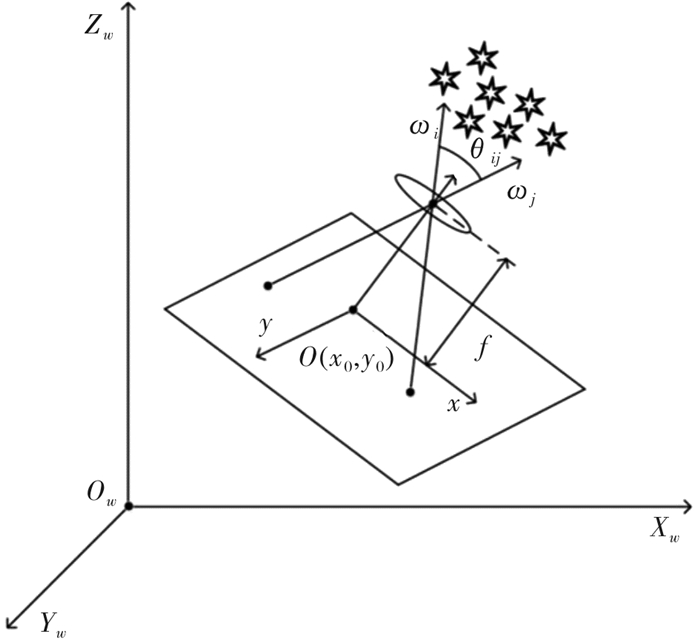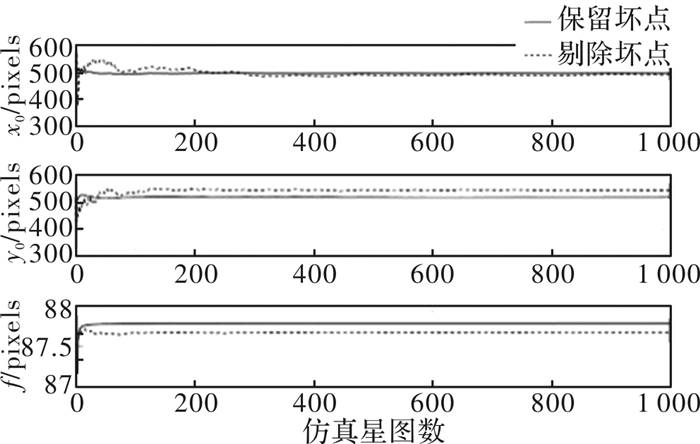Weighted on-orbit calibration method of principal point and focal length for star sensor
-
摘要: 星敏感器作为卫星姿态测量装置,其在轨服役过程中,主点和焦距的标定精度是影响其姿态输出精度的主要因素。针对标定过程中含有随机测量噪声偏大的星像点,导致星敏感器主点和焦距的标定结果产生较大偏差的问题,提出了一种星敏感器主点和焦距的加权在轨标定方法。该方法首先建立了星敏感器在轨标定模型,然后引入合理的标定权值,加入到最小二乘估计主点和焦距的过程中,寻找并剔除随机测量噪声偏大的星点,最后将加权估计出的结果作为测量,采用扩展卡尔曼滤波对星图进行处理。仿真结果表明,在星点位置存在较大误差的情况下,该方法能剔除随机测量噪声偏大的坏点。星内角距统计偏差约为传统方法的1/10,与真值相比标定参数精度分别为0.219 9像素、0.148 7像素、3.38 μm。Abstract: As a satellite attitude measurement device, the calibration accuracy of the star sensor's principal point and focal length serves as the main factor affecting the accuracy of its attitude output during the on-orbit service procession. If the calibration process contains the star image point with large random measurement noise, this will lead to large deviation of the calibration result of the star sensor's main point and focal length. Aiming at this problem, a weighted on-orbit calibration method of principal point and focal length for star sensor was proposed. Firstly, the method established the on-orbit calibration model of the star sensor.Then we added a reasonable calibration weight to the least squares estimation. In this way, we found and removed the points with large random measurement noise. Finally, the weighted least-squares estimation result was served as the measurement, and the extended Kalman filter was used to process the star image. The simulation results show that, if there is a large error in the position of the star point, this method can remove the bad points where the random measurement noise is too large. The statistical deviation of the angular distance is about 1/10 of the traditional method. Compared with the true value, the accuracy of the calibration parameters is 0.219 9 pixel, 0.148 7 pixel and 3.38 μm, respectively.
-
Keywords:
- star sensor /
- on-orbit calibration /
- weighted method /
- least squares estimation /
- Kalman filter
-
引言
相比于传统的舞台灯,LED舞台灯具有高效节能、发热少、响应时间快、性能稳定、寿命长等优势。使用大功率LED光源设计舞台灯透镜时,受芯片尺寸及出光角度的限制,很难设计出小角度的准直透镜。为了实现小角度照明的目的,设计人员通常设计出来的透镜尺寸会很大[1]。大尺寸的准直透镜设计不仅增加了生产成本还会影响舞台灯的灵活性。目前,实现LED舞台灯变焦的方式有多种,比较典型的是采用多片式透镜组[2-3]、整体菲涅尔透镜[4-5]或者反光杯加凸透镜[6]的方式。多片式透镜组的设计存在以下问题。首先,多透镜组无法收集利用大角度光束,造成光能浪费;其次,透镜的数量多于单颗透镜,导致灯具体积较大且笨重,影响灯具的正常操作;整体菲涅尔透镜在变焦时,需要移动整个透镜或LED光源,移动时的范围非常有限且不好控制;反光杯加凸透镜在变焦时,通过改变凸透镜与反光杯的距离来实现变焦,由于凸透镜尺寸较大且变焦过程移动距离过大,不利于LED舞台灯具的小型化,且成像后的色差很难控制[7]。无论哪种变焦透镜作用时,LED初始所形成的平行光线一定会被改变,且变焦范围都比较小,无法满足舞台灯光的照明需求。光束不可变或者变化范围小也是影响舞台灯发展的重要因素。国内大多数公司设计的LED舞台灯的光束角一般固定在12°或者24°,不能实现光束角的连续变化,且光学效率仅有65%。ROBE公司设计的LED摇头聚光灯,变焦范围仅有10°~15°[8]。
本文以非成像光学理论为基础,用试错法构造自由曲面[9],在全内反射式(total internal reflection,TIR)准直透镜的基础上,设计了一款适用于大功率RGBW全彩LED光源的变焦透镜系统。设计中采用光学仿真软件LightTools进行蒙特卡罗光线追迹。结果表明, 变焦透镜系统的半光束角变化范围为4°~53°,此光束角的范围是目前市面上变焦透镜的3倍多,在实际应用中可以替代光束角在此范围内的传统舞台灯。
1 LED准直透镜的设计及变焦透镜原理
1.1 LED准直透镜的设计
变焦透镜选用OSRAM(欧司朗)公司生产的S2WP作为光源,其功率为60 W,LED光源的整个封装为6 mm×6 mm。该光源是由R、G、B、W 4个发光芯片封装而成,如图 1所示。该LED光源为一个近似的朗伯型光源,其光束角为123°。3种颜色的LED芯片发出的单色光直接在空间混合成白光,由于不需要荧光粉的转换,避免了能量损失,且发光效率较高;可通过分别控制R、G、B 3种颜色的LED光强来间接控制色温,实现光色可调;通过选择LED的波长和强度得到更好的显色性。由于R、G、B 3色LED的光衰特性不同,该光源容易产生光斑色温分布不均匀的现象,因此需要对其进行二次光学设计。
为确保仿真光源与实际光源尽可能一致,LightTools仿真所用光源模型及光源文件均从OSRAM公司官网下载,分别插入Blue、Green、Red、White blue、White yellow这5种光源文件,并加载光谱。
准直透镜的设计主要采用旋转对称的折射-全反射的结构。其结构主要由3部分组成:平面折射镜、抛物面型的全反射面、自由曲面折射镜,如图 2所示。图 2(a)中O为LED光源中心点,OS为光轴,实线为光线的传播方向,分界线OM将光源发出的光线分成两部分,β为OM与水平方向的夹角,i为入射光线与水平方向的夹角。从图 2中可以看出,曲线cd为透射聚光部分,当入射角i>β,光源发出的光线经过内孔轮廓线cd直接发生折射聚光,增加了中心光强,能有效提高光能利用率[10];曲线ab为全反射聚光部分,当入射角i<β时,光源发出的光线经过小模芯内表面折射到曲线ab上发生全反射。最终这两部分光线平行于光轴出射,即形成准直光,并均匀地分布到接收屏上。
本文的准直透镜选用透光率为93%,折射率为1.49的PMMA(聚甲基丙烯酸甲酯,polymethyl methacrylate)材料,将发散的光重新分配,实现准直照明的效果。如图 2所示,在3D建模软件SolidWorks中建立一个光学高度51 mm,半径47 mm的透镜轮廓线,将其绕着光轴旋转360°,即为透镜的3D初始模型,如图 2(b)所示。
将上述3D初始模型导入光学仿真软件LightTools中进行光线追迹,在距离LED光源3 m处,放置一个尺寸为600 mm×600 mm的接受屏,结果如图 3所示。从图 3(a)可以看出,经过透镜的光线并没有平行出射。在对透镜进行准直优化过程中主要是对TIR轮廓线ab以及小模芯轮廓线cd进行优化。通过对初始结构进行多次优化调整,最终光线追迹图如图 3(b)所示,经过透镜之后的光线平行出射,表明此透镜为准直透镜。
1.2 舞台灯变焦透镜的结构及原理
不同于单颗凸透镜以及多片式透镜组的变焦结构,本文采用一种新型TIR结构设计舞台灯变焦透镜,如图 4所示。图 4中自左到右依次为TIR准直透镜和调焦片。变焦透镜的变焦原理:保持准直透镜的位置不变,将调焦片沿着光轴方向从与准直透镜相贴合的位置(T=0 mm)移动至与准直透镜最大调焦距离(T=15 mm)处,随着调焦距离T由0 mm增加到15 mm,变焦透镜的光束角由小到大变化。从图 4可看出,TIR准直透镜和调焦片组成了一个变焦透镜系统。
2 变焦透镜的设计及优化
2.1 变焦透镜的设计
不同于市面上其他舞台灯变焦透镜组的结构,本变焦透镜是在准直透镜的基础上添加双排复眼透镜阵列的结构[11],双排复眼透镜阵列的原理如图 5所示。第一列复眼透镜L1中各个小透镜与第二列复眼透镜L2中的小透镜一一对应,并且这两列复眼透镜的光轴互相平行。双排复眼透镜实现均匀照明的原理是,从准直透镜出来的平行光束照射到第一列复眼透镜上,光束经过每个小透镜聚焦到与之对应的第二列复眼透镜上,第一列复眼透镜将光源形成很多个光源像进行照明,第二列复眼透镜的小透镜将第一列复眼透镜对应的小透镜重叠成像在被照射面上。
本变焦透镜无需移动整个透镜,只需改变调焦片的位置,操作起来更方便。首先在准直透镜平面添加复眼透镜阵列,然后利用SolidWorks中的拉伸特征,拉伸出一个与该透镜相匹配的调焦片,通过调整调焦片与准直透镜的距离实现连续变焦。
当调焦片与透镜紧密贴合时,此时变焦透镜系统为聚光状态,光束角最小,可以看成一个准直透镜。当调焦片与准直透镜远离时,此时变焦透镜系统为泛光状态,从准直透镜出射的平行光经过平面上的复眼透镜阵列将光束分成很多个细光束聚焦到调焦片上相对应的复眼透镜的中心处,经过调焦片上复眼透镜阵列后光束照射到接收屏上,如图 6所示。
2.2 混光的优化
大范围变焦且混光效果好是舞台灯照明目前亟待解决的难题。图 7为准直透镜的效果图。图 7(a)为3 m处聚光时的照度图,可以看到,光斑的效果很不好,光斑中心有明显的暗区、光斑不均匀;图 7(b)为真彩图,可以看出,混光不理想,R、G、B光束分布比较明显,达不到舞台灯的照明要求。
在进行LED二次光学设计时,通常会受灯具尺寸、光源等实际条件的限制,使得普通TIR透镜很难达到理想的光斑均匀性。目前的解决方法有两种。一种是在透镜平面或者小模芯内表面晒纹[12-13],晒纹将光打散达到光斑均匀的效果,但晒纹无法在软件中精确地进行光线追迹,光效偏低,且在实际生产中很难保证稳定性;另一种则是在透镜平面或者小模芯内表面添加正六边形的复眼透镜阵列[14-15],光线经过正六边形复眼透镜阵列时,每个小透镜都会对经过它的光线进行汇聚,得到均匀的光斑。在使用正六边形复眼透镜阵列时需要注意的是,复眼透镜曲率较大时,通过它的光线就会发生全反射,造成菲涅尔损耗,同样会降低光效。除此之外,由于复眼透镜是将成像原理应用于非成像系统中,当复眼透镜的半径相对于LED透镜的半径较大时,总体的光斑会投射出六边形轮廓的图案,发生成像现象。
由于本文变焦透镜需要使用直径较大的复眼透镜来实现大范围变焦,考虑到以上2种方法的局限性,本文提出了一种新型不规则的六边形复眼透镜阵列结构,以解决光斑不均匀和混光差的问题。首先,在准直透镜的平面旋转出一个半径为5 mm,高2.7 mm的平凸透镜,以该透镜为中心,圆周填充阵列,各环间距为6.3 mm,实例间距为8.2 mm的不规则的六边形复眼透镜阵列,使得光线经过复眼透镜后能均匀分布,避免了光斑成像。然后,在透镜前表面旋转切除出一个半径为13.2 mm,深10.8 mm的孔,并在孔中分别旋转出一个半径2.3 mm和14.5 mm的非球面,也将这些工序称为对透镜前表面进行减胶处理。非球面的设计改变了部分光线的传播方向,使得更多光线到达接受屏的中心区域,减胶的设计不仅解决了光斑中心暗区的问题,同时也减少了材料、降低了成本。最后,对调焦片进行优化设计,调焦片靠近透镜侧中心,复眼透镜的设计避免了光斑中心太亮,远离透镜侧的小六边形复眼透镜设计提高了光斑的整体均匀性以及混光效果。透镜与调焦片表面的小复眼透镜的配合,使得在不降低中心光强的情况下大大提高了混光的程度,最终设计的结构如图 8所示。
最终聚光时的模拟结果如图 9所示。从图 9(a)的照度图可看出,光斑中心的暗区问题解决了,光斑均匀;从图 9(b)的真彩图可看出,R、G、B 3种颜色分布比较均匀,说明透镜前模芯子的设计以及调焦片的复眼透镜将光混合得比较好;从图 9(c)的光强分布曲线可知,光束角为4°,光学效率高达89%。以上分析可以确定光斑已经达到了预期的设计效果。
3 透镜的测试
经过一系列的模具加工和注塑,制作出了此款透镜,该调焦片与准直透镜能完美匹配,如图 10(a)与10(b)所示。受灯具的限制,在这里我们只验证聚光状态时的效果。透镜匹配欧司朗的S2WP全彩LED光源,照射到3 m远的墙面时,可实现照射均匀,混光效果好,没有明显的RGB颜色块,如图 10(c)所示。使用远方测试仪器对此款透镜进行测试,生成的报告显示,实测聚光时的光束角为4°,光学效率高达87%以上,如图 10(d)所示。实际变焦过程中光学效率相差不大。在实际应用中,灯具厂商会根据自己的需要,调试出合适的光束角和混光效果。
4 总结
本文针对以大功率LED为光源的舞台变焦灯具的需求,以欧司朗60 W的S2WP全彩LED为光源,利用变焦透镜组原理设计了一款由调焦片和准直透镜组合的变焦透镜系统。此款透镜是在TIR准直透镜的基础上圆周阵列填充多个非规则的六边形复眼透镜,通过移动调焦片与准直透镜的距离,实现光束角可调。经过光线追迹软件LightTools仿真,结果表明,透镜在0 mm~15 mm的调焦范围内,光束角变化范围为4°~53°,此变焦范围是市面上常见的变焦透镜的3倍多,光学效率高达87%以上。对于R、G、B、W 4种颜色封装芯片,整个透镜的变焦过程混光效果较好。相比于国内的其他舞台灯透镜,此款透镜具有更大的变焦范围、更好的混光效果、更高的光学效率。
-
-
[1] 乔培玉, 何昕, 魏仲慧, 等. 高精度星敏感器的标定[J]. 红外与激光工程, 2012, 41(10):2779-2784. doi: 10.3969/j.issn.1007-2276.2012.10.042 QIAO Peiyu, HE Xin, WEI Zhonghui, et al. Calibration of high-accuracy star sensor[J]. Infrared Laser Engineering, 2012, 41(10):2779-2784. doi: 10.3969/j.issn.1007-2276.2012.10.042
[2] 张磊, 周宇, 林荣峰, 等. 一种快速三角形星图识别算法[J]. 应用光学, 2018, 39(1):71-75. http://d.old.wanfangdata.com.cn/Periodical/yygx201801012 ZHANG Lei, ZHOU Yu, LIN Rongfeng, et al. Fast triangle star pattern recognition algorithm[J]. Journal of Applied Optics, 2018, 39(1):71-75. http://d.old.wanfangdata.com.cn/Periodical/yygx201801012
[3] 郝雪涛, 张广军, 江洁. 星敏感器模型参数分析与校准方法研究[J].光电工程, 2005, 32(3):5-8. doi: 10.3969/j.issn.1003-501X.2005.03.002 HAO Xuetao, ZHANG Guangjun, JIANG Jie. Star sensor model parameter analysis and calibration method[J]. Opto-electronic Engineering, 2005, 32(3):5-8. doi: 10.3969/j.issn.1003-501X.2005.03.002
[4] 贺鹏举, 梁斌, 张涛, 等. 大视场星敏感器标定技术研究[J]. 光学学报, 2011, 31(10):192-198. http://www.wanfangdata.com.cn/details/detail.do?_type=perio&id=gxxb201110035 HE Pengju, LIANG Bin, ZHANG Tao, et al. Calibration method for wide field of view star sensor[J]. Acta Optica Sinica, 2011, 31(10):192-198. http://www.wanfangdata.com.cn/details/detail.do?_type=perio&id=gxxb201110035
[5] Xie J, Tang H, Dou X, et al. On -orbit calibration of domestic APS star tracker[C]//Changsha, China: Earth Observation and Remote Sensing Applications, 2014 3rd International Workshop on, 2014: 239-242.
[6] SAMAAN M A, GRIFFITH T, SINGLA P, et al. Autonomous on-orbit calibration of star trackers[C].Colorado Springs:Core Technologies for Space Systems Conference (Communication and Navigation Session), 2001.
[7] 钟红军, 杨孟飞, 卢欣. 星敏感器标定方法研究[J]. 光学学报, 2010, 30(5):1343-1348. http://d.old.wanfangdata.com.cn/Periodical/yqyb201709008 ZHONG Hongjun, YANG Mengfei, LU Xin. Calibration method of star sensor[J]. Acta Optica Sinica, 2010, 30(5):1343-1348. http://d.old.wanfangdata.com.cn/Periodical/yqyb201709008
[8] LIU H, JIA H. Autonomous on-orbit calibration of a star tracker camera[J]. Optical Engineering, 2011, 50(2):68-68. http://www.wanfangdata.com.cn/details/detail.do?_type=perio&id=3028dfb73872e093abcd25fc1cec53e2
[9] MEDAGLIA E. Autonomous on-orbit calibration of a star tracker[C]// Florence, Italy:Metrology for Aerospace. IEEE, 2016. https://ieeexplore.ieee.org/document/7573258
[10] YAN K, LIU E, TIAN H, et al. Calibration of camera intrinsic parameters using a single image[C].Shanghai, China:International Conference, 2017:39-45.
[11] 张辉, 田宏, 袁家虎, 等. 星敏感器参数标定及误差补偿[J]. 光电工程, 2005, 32(9):1-4. doi: 10.3969/j.issn.1003-501X.2005.09.001 ZHANG Hui, TIAN Hong, YUAN Jiahu, et al. Parameter calibration and error compensation of star sensor[J]. Opto-electronic Engineering, 2005, 32(9):1-4. doi: 10.3969/j.issn.1003-501X.2005.09.001
-
期刊类型引用(1)
1. 胡滨. 色彩要素在舞台灯光设计中的应用. 传媒论坛. 2021(06): 169-170 .  百度学术
百度学术
其他类型引用(0)




 下载:
下载:















 陕公网安备 61011302001501号
陕公网安备 61011302001501号 